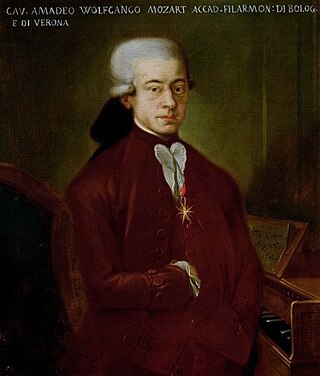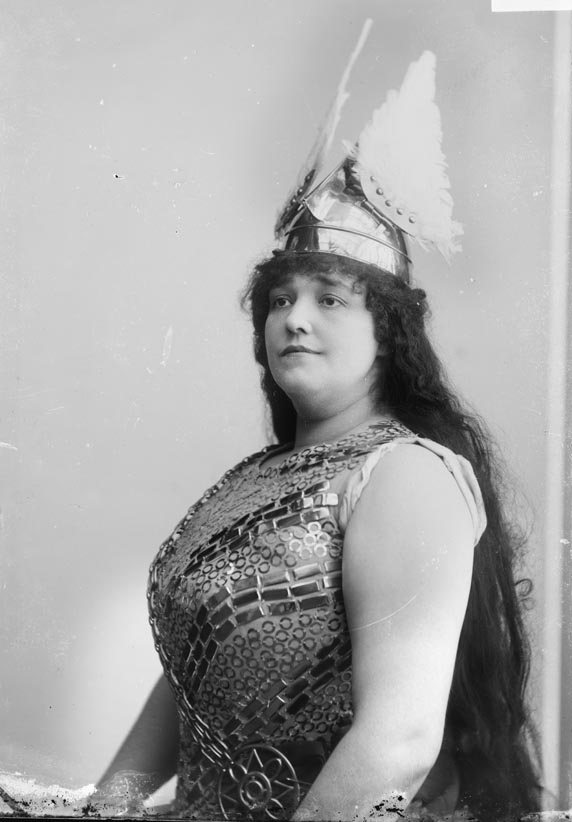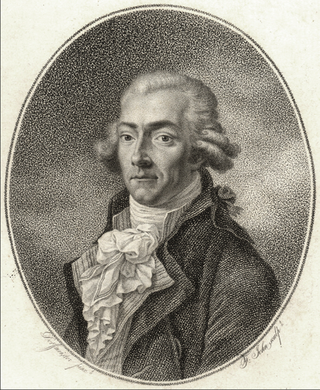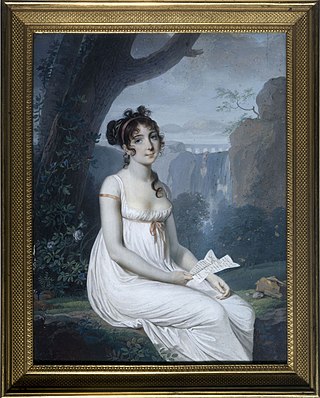
Antonio Salieri was an Italian composer and teacher of the classical period. He was born in Legnago, south of Verona, in the Republic of Venice, and spent his adult life and career as a subject of the Habsburg monarchy.

Don Giovanni is an opera in two acts with music by Wolfgang Amadeus Mozart to an Italian libretto by Lorenzo Da Ponte. Its subject is a centuries-old Spanish legend about a libertine as told by playwright Tirso de Molina in his 1630 play El burlador de Sevilla y convidado de piedra. It is a dramma giocoso blending comedy, melodrama and supernatural elements. It was premiered by the Prague Italian opera at the National Theater, now called the Estates Theatre, on 29 October 1787. Don Giovanni is regarded as one of the greatest operas of all time and has proved a fruitful subject for commentary in its own right; critic Fiona Maddocks has described it as one of Mozart's "trio of masterpieces with librettos by Da Ponte".

Amadeus is a play by Peter Shaffer which gives a fictional account of the lives of composers Wolfgang Amadeus Mozart and Antonio Salieri, first performed in 1979. It was inspired by Alexander Pushkin's short 1830 play Mozart and Salieri, which Nikolai Rimsky-Korsakov used in 1897 as the libretto for an opera of the same name.

La clemenza di Tito, K. 621, is an opera seria in two acts composed by Wolfgang Amadeus Mozart to an Italian libretto by Caterino Mazzolà, after Pietro Metastasio. It was started after most of Die Zauberflöte, the last of Mozart's principal operas, had already been written. The work premiered on 6 September 1791 at the Estates Theatre in Prague.

Il re pastore is an opera, K. 208, written by Wolfgang Amadeus Mozart to an Italian libretto by Metastasio, edited by Giambattista Varesco. It is an opera seria. The opera was first performed on 23 April 1775 in Salzburg in the Rittersaal of the Residenz-Theater in the palace of the Archbishop Count Hieronymus von Colloredo.

Amadeus is a 1984 American period biographical drama film directed by Miloš Forman and adapted by Peter Shaffer from his 1979 stage play of the same name. Set in Vienna, Austria, during the latter half of the 18th century, the film is a fictionalized story of Wolfgang Amadeus Mozart from the time he left Salzburg, described by its writer as a "fantasia on the theme of Mozart and Salieri". Mozart's music is heard extensively in the soundtrack. The film follows a fictional rivalry between Mozart and Italian composer Antonio Salieri at the court of Joseph II, Holy Roman Emperor. The film stars F. Murray Abraham as Salieri and Tom Hulce as Mozart. Abraham and Hulce were both nominated for the Academy Award for Best Actor, with Abraham winning.

Mitridate, re di Ponto, K. 87 (74a), is an opera seria in three acts by the young Wolfgang Amadeus Mozart. The libretto is by Vittorio Amedeo Cigna-Santi, after Giuseppe Parini's Italian translation of Jean Racine's play Mithridate.

Lorenzo Da Ponte was a Venetian, later American, opera librettist, poet and Roman Catholic priest. He wrote the libretti for 28 operas by 11 composers, including three of Mozart's most celebrated operas: The Marriage of Figaro (1786), Don Giovanni (1787), and Così fan tutte (1790). He was the first professor of Italian literature at Columbia University, and with Manuel Garcia, the first to introduce Italian opera to America. Da Ponte was also a close friend of Mozart and Casanova.

Tarare is an opéra composed by Antonio Salieri to a French libretto by Pierre Beaumarchais. It was first performed by the Paris Opera at the Théâtre de la Porte Saint-Martin on 8 June 1787. Salieri also reworked the material into an Italian version retitled Axur, re d'Ormus with libretto by Lorenzo Da Ponte, which opened in Vienna in January 1788.

Fra i due litiganti il terzo gode is a dramma giocoso in two acts by Giuseppe Sarti. The libretto was after Carlo Goldoni's Le nozze.

Falstaff, ossia Le tre burle is a dramma giocoso in two acts by Antonio Salieri, set to a libretto by Carlo Prospero Defranceschi after William Shakespeare's The Merry Wives of Windsor.

La fiera di Venezia is a three-act opera buffa, described as a commedia per musica, by Antonio Salieri, set to an Italian libretto by Giovanni Gastone Boccherini.
Johann Ignaz Ludwig Fischer, commonly called Ludwig Fischer, was a German opera singer, a notable bass of his time.

Ada Adini was an American operatic soprano who had an active international career from 1876 up into the first decade of the 20th century. She possessed a large, expressive voice which enabled her to sing a broad range of roles that extended from the coloratura soprano repertoire to dramatic soprano parts. She made five recordings with Fonotipia Records in Paris in 1905.

Vincenzo Calvesi was an Italian operatic tenor and impresario. A skillful lyric tenor, he began his career performing in opera houses in Italy during the 1770s. He was active in Dresden in 1782 to 1783 and then spent most of his time performing in Vienna from 1785 to 1794. He is best remembered today for creating the role of Ferrando in the world premiere of Wolfgang Amadeus Mozart's Così fan tutte in 1790. That same year the Viennese publication Grundsätze zur Theaterkritik described him as "one of the best tenors from Italy…with a voice naturally sweet, pleasant and sonorous." He was later active in Rome as an impresario up until 1811.

Francesco Benucci was an Italian bass/baritone singer of the 18th century. He sang a number of important roles in the operas of Wolfgang Amadeus Mozart, Antonio Salieri and other composers.

Per la ricuperata salute di Ofelia, K. 477a, is a solo cantata for soprano and fortepiano composed in 1785 by Antonio Salieri and Wolfgang Amadeus Mozart, and a third, unknown composer, Cornetti, to a libretto written by the Vienna court poet Lorenzo Da Ponte. It is speculated that "Cornetti" may refer to Alessandro Cornetti, a vocal teacher and composer active in Vienna at the time, or that it is a pseudonym of either Salieri or Stephen Storace, a composer who organized the collaborative work to honor his famous sister. The music had been considered lost until November 2015, when German musicologist and composer Timo Jouko Herrmann identified the score while searching for music by one of Salieri's ostensible pupils, Antonio Casimir Cartellieri, in the archives of the Czech Museum of Music in Prague.

Luisa Laschi, also known as Luisa Laschi-Mombelli, was an Italian operatic soprano prominent in the opera houses of Austria and Italy. Amongst the numerous roles she created in her brief but intense career were Countess Almaviva in Mozart's Le nozze di Figaro, Aspasia in Salieri's Axur, re d'Ormus, and Isabella in Martín y Soler's Una cosa rara. Laschi was the first wife of the tenor Domenico Mombelli by whom she had two children, both of whom died in infancy.

Le nozze di Figaro is a 168-minute studio recording of Wolfgang Amadeus Mozart's opera of the same name, performed by a cast of singers headed by Sir Thomas Allen, Jane Berbié, Yvonne Kenny, Philip Langridge, Kurt Moll, Lucia Popp, Samuel Ramey, Frederica von Stade, Robert Tear and Dame Kiri Te Kanawa with the London Philharmonic Orchestra under the direction of Sir Georg Solti. It was released in 1982.

Carolina Crespi, later known as Carolina Crespi-Bianchi and Carolina Bianchi, was an Italian soprano active on the opera stages of Paris and Northern Italy from 1803 to 1820. She was born in Prague, the daughter of the soprano Luigia Prosperi-Crespi (1770–1824). Crespi was married to the tenor Eliodoro Bianchi and appeared with him in three world premieres at La Scala.



















